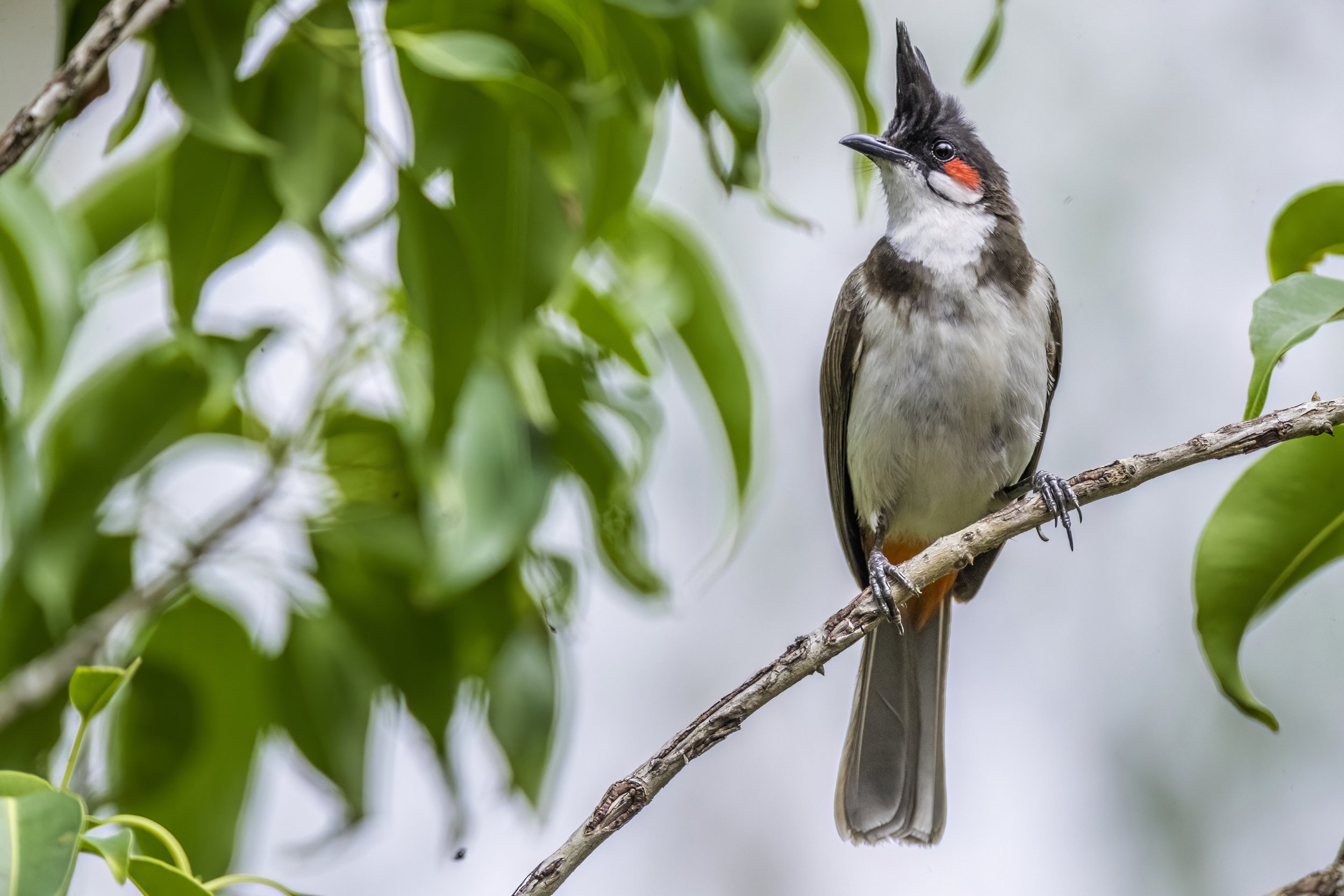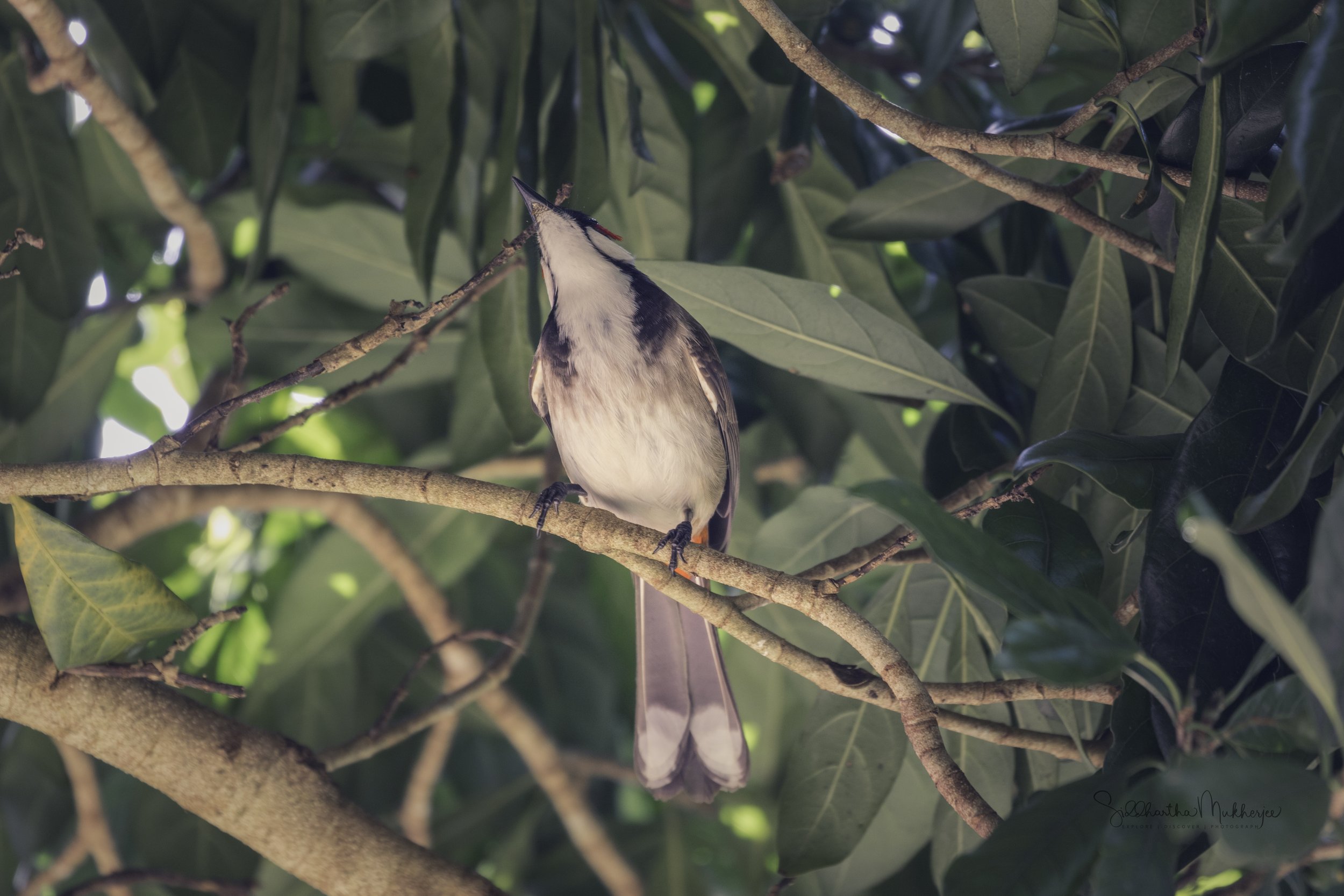Red-whiskered Bulbul
Pycnonotus jocosus
Panchgani, Maharashtra & Doi Pha Hom Pok National Park, Chiang Mai, Thailand
In this fifth part on the series on bulbuls, we are on the trail of the red-whiskered bulbul and we return again to the dois of north Thailand. About 685 kilometers to the north of Bangkok lies the former seat of the ancient Lanna Kingdom & is considered one of the most scenic provinces in the country given its mountain ranges, valleys, flora and fauna. A land of misty mountains and colourful hill tribes, a playground for seasoned travellers, and a delight for adventurers. Despite its relatively small size and blissful calm, Chiang Mai truly has it all, a city that is still firmly Thai in its atmosphere and attitude. It is the second-largest changwat (province) of Thailand. Bordered by Chiang Rai to the northeast, Lampang and Lamphun to the south, Tak to the southwest, Mae Hong Son to the west and the Shan State of Myanmar to the north. Located in a verdant valley on the banks of the Ping River, Chiang Mai was founded in 1296 as the capital of the ancient Lanna Kingdom. Today it is a place where past and the present seamlessly merge with modern buildings standing side by side with venerable temples. Of all the places I have visited in Thailand, Chiang Mai with its forests and mountains and the historic city of Ayutthaya are by far my favourites. Thailand has been kind to me in terms of bird and wildlife photography and even otherwise when I have visited as a tourist. It is a country rich in culture, history and abundant wildlife. The Thai people are some of the gentlest people I have met and genuinely go out of their way to make a visitor comfortable. The following blogs showcase some of the beautiful people, birds and wildlife I have had the opportunity to meet.
Read about my other Bulbuls:
And now onto the Red-whiskered Bulbul.
The word Chiang itself is from North Thai, or Lanna, meaning town or city and Mai means new making Chiang Mai the New City as it was founded later than Chiang Rai, the earlier capital of King Meng Rai. The districts in the province are called amphoe, and sub-districts are called tambon. Another twist is the use of Nakhon (or Nakorn or Nakhorn), derived from the Sanskrit word Nagara, also means city, though strictly speaking it refers to a capital city such as Nakorn Sri Ayutthaya (more on Ayutthaya later). Indeed to emphasise its former status you may sometimes see Chiang Mai referred to as Nakhon Ping. Other common names of geographical features include mae (river) and doi which is north Thai for mountain - for example Doi Inthanon and Mae Ping.
The four Dois we spent our time on were Doi Inthanon, Doi Ang Khang, Doi Luang and Doi SanJu.
Doi Ankhang is a mountain belonging to the Himalayan foot hill range, located at the Myanmar (Burmese) border. The highest point is 1,928 metres. Although chiefly deforested, this is still one of Northern Thailand’s most prominent birdwatching areas, due to more and rarer bird species being in residence, as well as being a popular resting point for numerous migratory birds. Examples of rare and beautiful birds inhabiting this area include the Spot-breasted Parrotbill and the Red-faced Liocichla. A highly recommend site to find the rarest bird species is the picturesque area named Heavenly Valley. It is not so uncommon to spot the Red-tailed Laughing Thrush here. Around The Royal Agricultural Project Station you can find Brown, Burmese and Long-tailed Shrike and also Fire-capped Tits and Silver-eared Mesia, White – tailed Robin & Maroon Oriole.
We didn’t have the good fortune to see all the species on all the mountains, that would have been impossible, but we did rack up quite a number of species - about 95 of them. The gallery today is the fifth in my series on bulbuls featuring the red-whiskered bulbul.
‡‡‡‡‡
For a print of the beautiful birds from the Dois click on the button below to read my process and order a limited edition canvas.
‡‡‡‡‡
Red-whiskered Bulbul
The red-whiskered bulbul (Pycnonotus jocosus), or crested bulbul, is a passerine bird found in mainly in tropical Asia. It is a resident frugivore throughout its range and has been introduced in many tropical areas of the world where populations have established themselves. It feeds on fruits and small insects. Red-whiskered bulbuls perch conspicuously on trees and have a loud three or four note call. They are very common in hill forests and urban gardens within their range.
This bulbul is about 20 centimetres (7.9 in) in length. It has brown upper and whitish underparts with buff flanks and a dark spur running onto the breast at shoulder level. It has a tall pointed black crest, red face patch and thin black moustachial line. The tail is long and brown with white terminal feather tips, but the vent area is red. Juveniles lack the red patch behind the eye, and the vent area is rufous-orange.
Species in the same genus:
Pycnonotus blanfordi, Ayeyarwady bulbul
Pycnonotus brunneus, Red-eyed bulbul
Pycnonotus cafer, Red-vented bulbul
Pycnonotus finlaysoni, Stripe-throated bulbul
Pycnonotus goiavier, Yellow-vented bulbul
Pycnonotus jocosus, Red-whiskered bulbul
Pycnonotus plumosus, Olive-winged bulbul
Pycnonotus simplex, Cream-vented bulbul
Pycnonotus sinensis, Light-vented bulbul
Pycnonotus xanthorrhous, Brown-breasted bulbul
Pycnonotus zeylanicus, Straw-headed bulbul
The loud and evocative call of the red-whiskered bulbul is a sharp kink-a-joo (also transcribed as pettigrew or kick-pettigrew or pleased to meet you) and the song is a scolding chatter. It is more often heard than seen, but will often perch conspicuously especially in the mornings when they call from the tops of trees. The life span is about 11 years.
This is a bird of lightly wooded areas, more open country with bushes and shrubs, and farmland. Irruptions have been noted from early times with Thomas C. Jerdon noting that they "periodically visiting Madras and other wooded towns in large flocks."
It has established itself in Australia and in Los Angeles, Hawaii, and Florida in the United States, as well as in Mauritius, on Assumption Island and Mascarene Islands. In Florida, it is only found in a small area, and its population could be extirpated easily. It was eradicated from Assumption Island in 2013–2015 to prevent colonisation of nearby Aldabra, the largest introduced bird-free tropical island.
The red-whiskered bulbul was introduced by the Zoological and Acclimatisation Society in 1880 to Sydney, became well established across the suburbs by 1920, and continued to spread slowly to around 100 km away. It is now also found in suburban Melbourne and Adelaide, although it is unclear how they got there.
I was fortunate to photograph 9 of 14 of these beautiful bulbuls like the Red-whiskered Bulbul featured here, Sooty-headed Bulbul, Red-eyed Bulbul, Red-vented Bulbul, Streak-eared Bulbul, Flavescent Bulbul, Yellow-vented Bulbul, Olive-winged bulbul & the Cream-vented bulbul.
It was an interesting situation with this bulbul and this particular part of my trip. Here I have used both the Canon 7D Mark ii & Canon 1Dx Mark ii paired with the Tamron SP 150-600mm G2 & EF 100-400mm f/4.5-5.6L IS II USM. The G2 is a great lens but it well and truly struggles to focus in the shadows and it took a fair bit of work to get some of the photos I have especially of the Streak-eared Bulbul.
With that said I think it is time to move onto the gallery of this beautiful bulbul.
‡‡‡‡‡
Related Posts



















